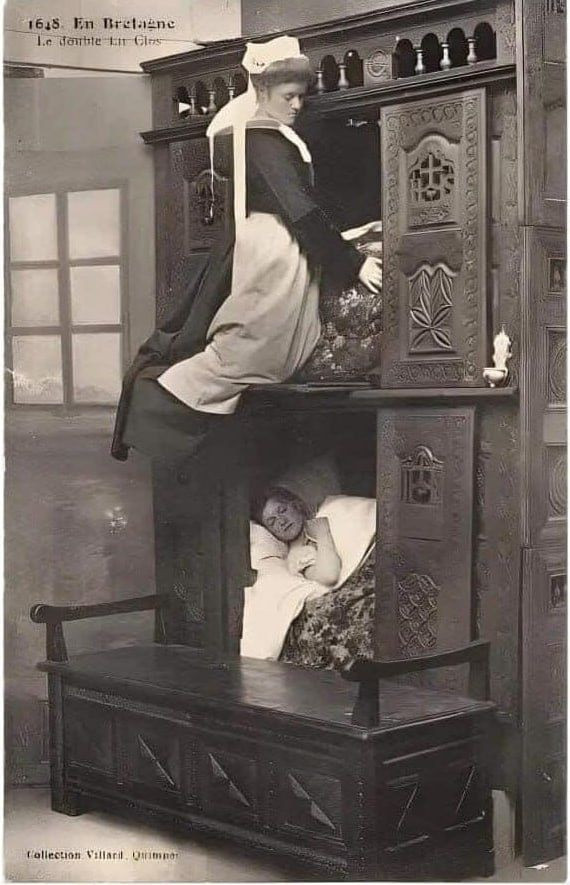The Enigmatic Box Bed: A Cozy Refuge from Cold Winters

In the heart of winter, when the cold winds howl and frost creeps into every corner of a home, the quest for warmth becomes paramount. In the colder regions of northern Europe, the struggle to maintain heat within the walls of a house was a matter of survival. Fortunately, amidst this backdrop of biting cold, a forgotten craftsman's ingenuity revolutionized how people slept: the box bed.
Origins of the Box Bed
The origins of the box bed can be traced back to the late medieval period, around the 16th century. As families gathered around the flickering embers of a fire, they sought shelter from the chilling draughts that invaded their homes. This is where the concept of the box bed emerged—a cleverly constructed sleeping space resembling a closet, designed to trap heat and provide respite from the frigid air.
Crafted primarily from wood, these beds came in various forms, with designs tailored to different regions. From England to Scotland, Austria to the Netherlands, and throughout Scandinavia, the box bed became a ubiquitous solution to a common problem. Some variations had intricate carvings, showcasing the artistry of the craftsmen of the time, while others were more utilitarian, emphasizing function over form.
The Role of the Box Bed in Everyday Life
For many, the box bed was more than a place to sleep. It became a cozy refuge, a sanctum where families could huddle together on bitterly cold nights. With the warmth emanating from the modest wood fire often limited to the communal living space, the box bed’s design offered a smart solution for keeping the night’s chill at bay.
Imagine a family of four retreating to their box bed after a long day of toil. The parents would tuck their children in, pulling the thick wool blankets tight around them, but the real magic lay in the enclosed design of their sleeping quarters. No longer exposed to the relentless cold, they could find solace within the wooden walls, cherishing the warmth that encased them in a wooden embrace.
As the last flicker of the family fire faded away, the box bed provided safety and comfort, buffering against winter’s grasp. A cramped space it may seem to modern sensibilities, but for those living in that era, it was a luxurious retreat from the harsh realities outside. The box bed represented more than just a sleeping arrangement; it symbolized family togetherness and the fight against nature’s elements.
Cultural Variations
Throughout Europe, the box bed adapted to local cultures and traditions, embodying the styles of different regions. In Britain, you might find greater emphasis on craftsmanship, with decorative joints and fine wood finishes. Scottish box beds often incorporated tartan textiles, reflecting local patterns and customs. The Dutch version might include a more minimalist design, focusing on maximizing space in the typically smaller homes prevalent at the time.
Despite the distinctions in style, the underlying purpose remained uniform—the need to provide warmth and security against winter’s chill. Some box beds even included clever accessories, such as shutters or curtains, allowing for additional insulation and privacy. Children would be nurtured and kept safe, enveloped in warmth and the comfort of family.
The Evolution of Heating
By the time the 20th century rolled around, the box bed still held its ground in many households. But with the advent of modern heating systems, this ingenious creation began to fade into obscurity. Central heating revolutionized how homes were constructed and how families interacted with their spaces. The once essential box bed became an artifact of a bygone era, relegated to the dusty corners of history.
However, as people began to seek connection to the past, there was a resurgence of interest in traditional crafts and lifestyles. The box bed, once a symbol of survival, became appreciated not just for its practicality but also for its historical significance. Today, these beds are seen as a way to connect with our ancestors, a tangible reminder of the strength and resilience of those who came before us.
Resilience and Ingenuity
The importance of the box bed reflects a broader narrative: the remarkable resilience and ingenuity of humanity in the face of adversity. While it may seem like merely a wooden structure, it embodies the spirit of survival, adaptation, and community. The box bed was, in many ways, a lifeline—a sanctuary from the elements that fostered togetherness in an uncertain world.
Families would gather within these wooden enclaves, sharing stories, laughter, and warmth. The box bed facilitated not only physical comfort but emotional connection. It created an intimate space where relationships blossomed and memories were formed, demonstrating how simple design can yield profound impact.
Lessons for Today
As we navigate our own modern challenges, the teachings of the box bed resonate deeply. In a world where technology dominates and our homes are often vast and impersonal, the appeal of cozier, more intimate living spaces has grown. Perhaps we can take a page from history—recognizing the value of nurturing human connections, embracing simplicity, and finding comfort in close quarters.
As the winters continue to chill the air, let us not forget the lessons learned from those who once relied on the box bed. This humble yet ingenious solution had a vital role in their survival and well-being. By reflecting on the past, we can cultivate a sense of warmth and community in our own lives, no matter the challenges we face.
In celebrating the box bed, we honor the craftsmen who laid the foundation for today’s designs, recognizing their role in shaping a future that values ingenuity, resilience, and the warmth of human connection. So the next time winter grips your surroundings, consider the ingenuity of those who came before us—a tradition of warmth, a legacy of safety, and a testament to the enduring spirit of humanity.














Comments
0 comment